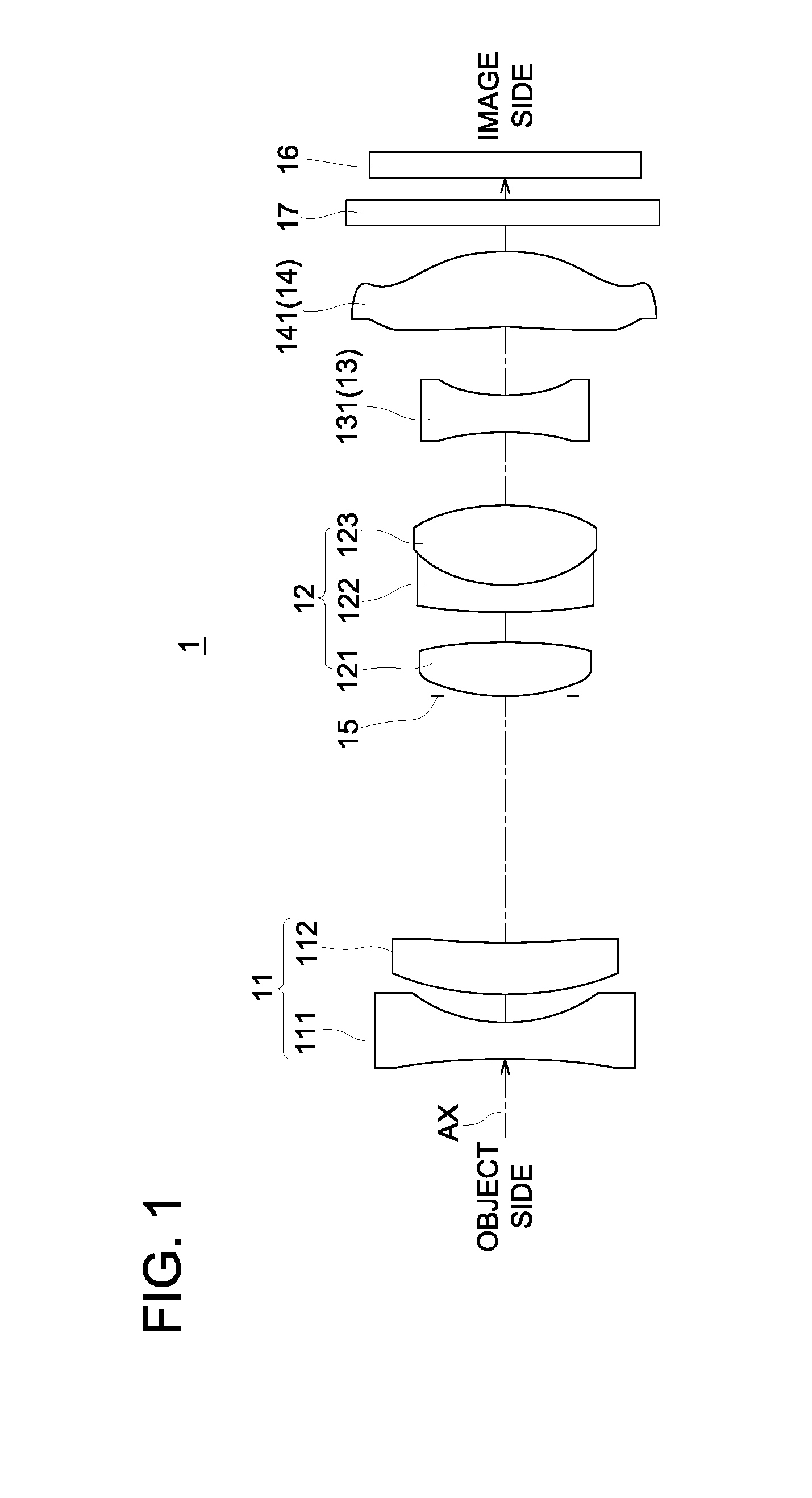Variable-power optical system, image pickup device, and digital apparatus
a technology of optical system and image pickup, applied in the field of variable-power optical system, image pickup device, digital apparatus, can solve the problems of insufficient correction of astigmatism and chromatic aberration, severe size and cost restrictions, increased costs, etc., to achieve effective correction, compact configuration, and reduce costs
- Summary
- Abstract
- Description
- Claims
- Application Information
AI Technical Summary
Benefits of technology
Problems solved by technology
Method used
Image
Examples
example 1
[0209]FIG. 4 is a cross sectional view (optical path diagram) traversing the optical axis AX, representing the arrangement of lens groups in the variable-power optical system 1A of Example 1. The optical path diagrams of FIG. 4 and FIG. 5 through 15 show the lens arrangement at the wide-angle end (W). Throughout Example 1 and Examples 2 through 12 to be described below, these lens groups include a first lens group (Gr1) having a negative optical power as a whole, a second lens group (Gr2) having a positive optical power, a third lens group (Gr3) having a negative optical power, and a fourth lens group (Gr4) having a positive optical power, in that order as viewed from the object side in the drawings (the left side in FIG. 4). To put it another way, the lens groups are aligned in a negative-lead configuration wherein the first lens (Gr1) closest to the object has a negative optical power and are provided as a four-component variable-power optical system with negative, positive, negat...
example 2
[0223]FIG. 5 is a cross sectional view traversing the optical axis (AX), representing the arrangement of the lens groups in the variable-power optical system 1B in Example 2. The variable-power optical system 1B in Example 2 includes a first lens group (Gr1) having a negative optical power as a whole, an optical stop (ST), a second lens group (Gr2) having a positive optical power as a whole, a third lens group (Gr3) having a negative optical power, and a fourth lens group (Gr4) having a positive optical power, in that order as viewed from the object side. To put it in more detail, the first lens group (Gr1) is composed of a biconcave negative lens (L1) and a positive meniscus lens (L2) with a convex surface facing the object side, in that order as viewed from the object side. The second lens group (Gr2) is composed of a biconvex positive lens (L3) and a biconcave negative lens (L4) arranged in that order as viewed from the object side. The third lens group (Gr3) is composed of one n...
example 3
[0226]FIG. 6 is a cross sectional view traversing the optical axis (AX), representing the arrangement of the lens group in the variable-power optical system 1C of Example 3. The variable-power optical system 1C of Example 3 includes a first lens group (Gr1) having a negative optical power as a whole, an optical stop (ST), a second lens group (Gr2) having a positive optical power as a whole, a third lens group (Gr3) having a negative optical power, and a fourth lens group (Gr4) having a positive optical power, in that order as viewed from the object side. To put it in more detail, the first lens group (Gr1) is composed of a biconcave negative lens (L1) and a positive meniscus lens (L2) with a convex surface with the object side, in that order as viewed from the object side. The second lens group (Gr2) is composed of a biconvex positive lens (L3) and a biconcave negative lens (L4), in that order as viewed from the object side. The third lens group (Gr3) is composed of one negative men...
PUM
 Login to View More
Login to View More Abstract
Description
Claims
Application Information
 Login to View More
Login to View More - R&D
- Intellectual Property
- Life Sciences
- Materials
- Tech Scout
- Unparalleled Data Quality
- Higher Quality Content
- 60% Fewer Hallucinations
Browse by: Latest US Patents, China's latest patents, Technical Efficacy Thesaurus, Application Domain, Technology Topic, Popular Technical Reports.
© 2025 PatSnap. All rights reserved.Legal|Privacy policy|Modern Slavery Act Transparency Statement|Sitemap|About US| Contact US: help@patsnap.com



